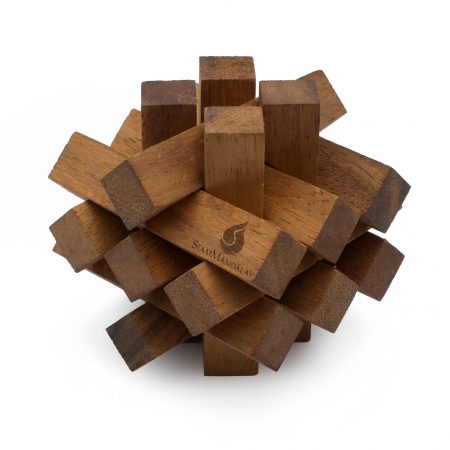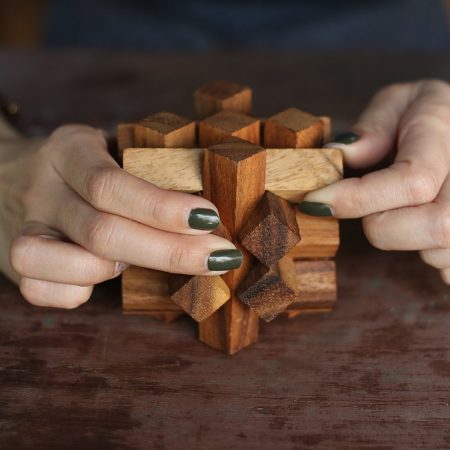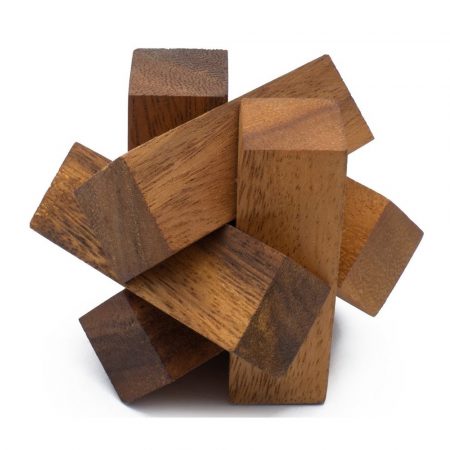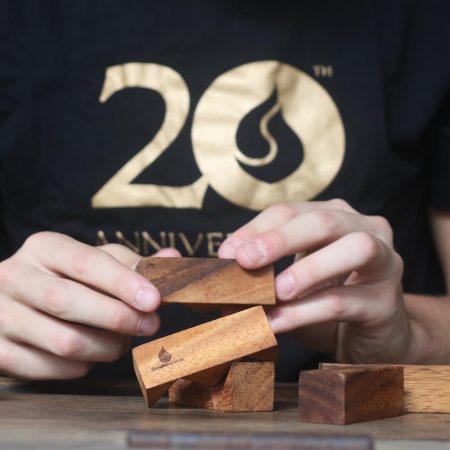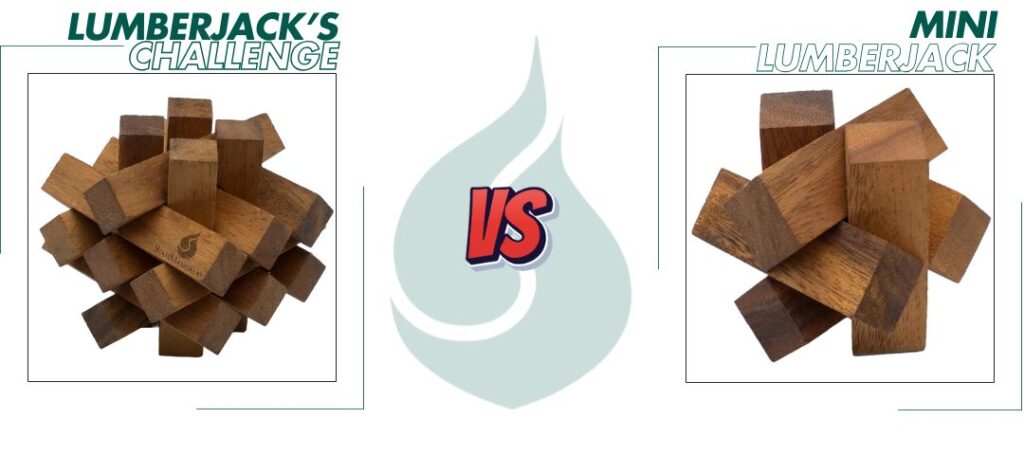
Both the Lumberjack’s Challenge and the Mini Lumberjack come from the same family of 3D puzzle known as burr puzzles. Burr puzzles are known for their interlocking pieces, with notches carved out, allowing them to come together and form a 3D symmetrical shape or unit. These puzzles can appear in a number of different shapes, but some of the most common are those that share a similar look to our Lumberjack puzzles. Puzzles with sticks facing in all directions, overlapping and connecting conveniently to lock together in place. From there, in order to disassemble the puzzle, one or more pieces must be removed from the greater construction in order to begin, often known as a “key” this piece is typically the only one that comes out freely when assembled. To assemble the puzzle, all of the pieces must come back together to form the original, often symmetrical, shape. If you would like to read more about burr puzzles, check out our previous blog here.
Probably the most well-known, and likely the oldest burr puzzle out there is the six piece burr, also known as a puzzle knot. The Mini Lumberjack is a variation of this classic puzzle that has been flipped on its side. It is a sort of diagonal version of the traditional six-piece burr, allowing it to more closely resemble felled logs. The sized-up version of this Mini Lumberjack puzzle, the Lumberjack’s Challenge, is a fifteen-piece burr puzzle that is similarly designed to look like a geometric construction of logs.
These puzzles are similar in their style and construction. They maintain similar looks that are reminiscent of logs, but differ in a number of meaningful ways. Perhaps the most impactful being the differing number and types of pieces that each puzzle has. The Mini Lumberjack has just six pieces which are identical in shape, all containing the same grooves and divots carved out of them. Whereas the bigger Lumberjack’s Challenge contains 15 pieces with five different variations in shape. Allowing for a more complex array of possibilities, and mistakes, when attempting to complete the puzzle.
When there is such a large difference in the number and kinds of pieces that compose each puzzle, there can sometimes be a big difference in difficulty that goes along with it. Our Lumberjack Puzzles are no different. We rate the difficulties of all our puzzles on a scale from 1-3, with one being the easiest and three the hardest. Largely due to these differences between the puzzles’ pieces, Mini Lumberjack has a difficulty rating of one, compared to the Lumberjack’s Challenge’s rating of three. This means that we estimate it to take significantly longer and require a much more seasoned puzzler to complete the Lumberjack’s Challenge as opposed to the Mini. The range in difficulty between them also means that they work better for different instances and uses. The Mini Lumberjack for example is perfect to rest on a work desk or a coffee table when it is not in use. Thanks to its compact size and intriguing visual appeal, it draws in challengers wherever can be seen. Due to the ease with which it can be taken apart and put together quickly, it’s perfect for guests and passersby to give it a try. Whereas with the Lumberjack Challenge, if it is placed in a high foot-traffic area, and everyone wants to try it out for themselves, it will likely be too difficult to constantly put it back together. More often than not, it would probably stay as a pile of sticks, which is why we recommend keeping it on a bookshelf or end table. Somewhere that people will spend a more extended period of leisure time, rather than a quick mental or fidgeting break during the day. Furthermore, thanks to its larger size, it will also stand out and draw attention no matter where it’s displayed.
These nuances make each puzzle unique and valuable for their own different reasons. The Lumberjack’s Challenge is best approached as a project. Something that an individual or a group sit down and focus time on attempting to complete. Whereas the Mini Lumberjack is a bit more versatile. On the first try, it can make for a similarly mysterious puzzle experience, however thanks to the nature of its pieces, it is easier to accomplish through trial and error than its larger counterpart. A different approach is required to complete each puzzle, and for that reason it is worth having both in your collection.
Through these vast visual, logical, and practical differences, key similarities still ring true between these Lumberjack themed brainteasers. What doesn’t change is the SiamMandalay branding and promises. With each puzzle we employ exceptional craftsmanship and refuse to cut corners or compromise on premium materials or handiwork. We take pride in every piece that comes out of our shop, which is why for the Lumberjack and Mini Lumberjack, like all of our puzzles, we offer a complete lifetime guarantee. If the puzzle ever breaks, we would be happy to send you another one free of charge.

